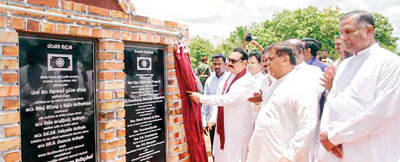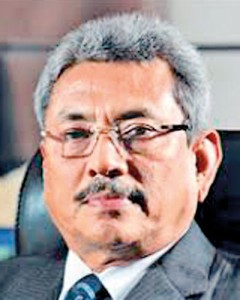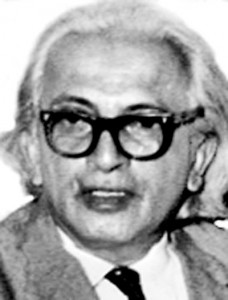Sunday Times 2
Ancient irrigation works must be restored, not destroyed
The Government has started a project to divert the waters of Yan Oya with Chinese aid. The proposed reservoir of this project will not only inundate a large extent of paddy lands which are presently irrigated by ancient irrigation works but will also inundate some of the ancient ruins in this area. This project will also displace many Sinhala villages. Without resettling these villages in an entirely new habitat, the Government should cancel this project which would result in so much destruction and restore the ancient irrigation works under the Padaviyawewa command area to usher in sustainable development to the entire Yan Oya river basin as in ancient times.

President Mahinda Rajapaksa inaugurating the Yan Oya Reservoir Project in August 2012
The term “wewa” is used to refer to an artificial lake or pond or other means of storing water on the surface of the ground which has been constructed by local people with indigenous skills from pre-biblical times to pre-colonial times while the word reservoir refers to a similar but more recent irrigation practices of storing water. These are usually constructed at sites that have not been exploited to construct wewas in the past. There are more than 30,000 wewas constructed by our ancestors. Of these ten thousand or nearly one third are presently working wewas outside the present major irrigation schemes. These working wewas irrigate about 250,000 acres of paddy in the dry zone. There are still an abundance of wewas in the dry zone and they are in ruins and need restoration.
The earliest recorded river diversion was by King Vasabha (127 to 171 AD) nearly 1800 years ago when he constructed the Elahera anicut with 17 miles of canal to convey water to Minneriyawewa. Then more than 1,500 years ago King Dathusena (460 to 478AD) constructed the Kalawewa with a two and a half mile bund involving over a million cubic metres of earth work. He also built a canal of 54 miles known as the Jaya Ganga with a gradient of six inches to a mile to convey water from the Kalawewa to the Nuwarawewa in Anuradhapura. The Nuwarakalaviya tank civilisation was built around three large wewas — the Nuwarawewa,

Defence Secretary Gotabaya Rajapaksa helped restore the anicut
the Kalawewa and the Padaviyawewa. While extensive study has been conducted pertaining to the irrigation works in the command area of Nuwarawewa and Kalawewa, little is known of the irrigation canals which supplied water to the Padaviyawewa or the irrigation works that existed in its command area in the Yan Oya river basin.
The town of Horowupotana is situated about half way along the Anuradhapura Trincomalee road 56 kilometres from Anuradhapura. The name Horowupotana has been derived from the Sinhalese words horowuwa ippaduna sthanaya. While horowuwa in Sinhalese means sluice gate ippaduna sthanaya when translated from Sinhalese to English means where it originated. Therefore Horowupotana is where the sluice gate of an ancient irrigation canal supplying water to the Padaviyawewa from Yan Oya originated.
The ruins of this ancient canal of over 55 kilometers were traced by P.U. Ratnatunga, a former Surveyor General. The sluice gate and the anicut across the Yan Oya from where the ancient canal originated would have existed about two kilometers upstream from the present bridge across Yan Oya which is situated five kilometers from the Horowupotana town on the Horowupotana Aluthoya road. According to the tracing made by Ratnatunga, the ancient anicut across Yan Oya would have first diverted the waters of Yan Oya to Maha Hambarayawewa. The first part of the ancient canal links Maha Hambarayawewa with Tirappankadawalawewa. The next part of the canal links Tirappankadawalawewa with the Maradankadawala Wewa.
From Maradankadawalawewa the ancient canal was traced below the Relapanawahinna hill feature proceeding to the Relapanawawewa. It then links Relapanawawewa with Ambagaswewa. It next links Ambagaswewa with Kapugollewawewa. The tracing continues from Kapugollewawewa to Migaskada where it crossed a tributary of Halmillewa Oya and continues to Tamarawewa. Either at Migaskada or from Tamarawewa this water diverted from Yan Oya would have been supplied to Wahalkadawewa along Halmillewa Oya. The next part of the ancient canal has been traced below the Andiyagala hill feature to the Andiyagalawewa. The final part of the canal was traced from Andiyagalawewa to Kahatagollewa where it connects to the Mora Oya which takes water to the Padaviyawewa.

Former Surveyor General P.U. Ratnatunga
The ancient canal from Horwupotana to Wahalkada and Padaviya runs between the 200 and 220 foot contours traversing a distance of about 33 miles. It would have been constructed over 1,600 years ago by King Mahasena (334 to 362AD) and it augmented the storage capacity of not only these two tanks with water from Yan Oya but hundreds of small village tanks situated below the level of this canal. The Padaviyawewa built by King Mahasena 1,600 years ago was restored more than 800 years ago by King Maha Parakkamabahu (1153 to 1186 AD). It is this great king who once said, “let us not allow a single drop of rain water to flow into the ocean without being utilised to irrigate the fields”. His wishes were indeed made a reality in the Yan Oya river basin by this ancient canal.
The existence of this canal in ancient times has received no publicity due to little or no research being done in this field. If this canal is restored to its former glory it would provide irrigation to thousands of acres of paddy in the Yan Oya river basin converting this area once more as in ancient times to one of the major granaries of our country. The cost of restoring this ancient canal would be much less than the expenditure that would be incurred for the proposed destructive Yan Oya diversion project that is to be implemented with Chinese aid. The restoration of the ancient irrigation canal will not displace villagers living in the Yan Oya river basin and would also preserve the valuable forest cover available in this area which is now earmarked for felling to implement the new Yan Oya river diversion project with Chinese aid.
Based on the information that I had gathered I prepared a project proposal to restore this ancient canal. When Gotabaya Rajapakse was appointed as the Secretary of Defence he summoned me to his residence and wanted me to brief him on my proposal to restore this ancient canal. He subsequently summoned the Irrigation Ministry Secretary A.D.S. Gunawardena and several irrigation engineers to his office and requested me to brief them with regard to my project proposal and when I did so except for the Irrigation Ministry Secretary, the other irrigation engineers had a negative attitude towards my project proposal and said that water could not be diverted from the Yan Oya to the Padaviyawewa. I then gave them the ancient canal tracing made by former Surveyor General P.U. Ratnatunga. The engineers wanted time to study the tracing. They were given the needed time by the Defence Secretary and another meeting was called subsequently at which the engineers accepted the possibility of diverting water from Yan Oya to Padaviyawewa along the ancient canal traced by Ratnatunga.
Thanks to the initiative taken by the Defence Secretary, the money necessary to construct an anicut across Yan Oya was allocated and the construction of this anicut was duly completed. The anicut, however, was constructed about two kilometers upstream from its original ancient location to enable several more village tanks to be augmented before the newly constructed canal took the diverted water from Yan Oya to the Tirappankadawalawewa. Some restoration work on the ancient canal was subsequently done by the irrigation department but the total extent of this ancient canal was never restored to convey the diverted water from Yan Oya to the Padaviyawewa for reasons best known to the department of irrigation.
Instead of restoring this ancient irrigation canal that would usher in prosperity to the entire Yan Oya river basin as in ancient times, the Government misled by people with vested interests has now started another Yan Oya diversion project further downstream with Chinese aid. Is this new project being implemented to benefit corrupt politicians and contractors appointed by them? Will the forest cover containing many valuable trees in the project area that has to be cleared be estimated at firewood value but sold as class 1 timber to benefit corrupt politicians and their contractors?
The Chinese no doubt will benefit by collecting the interest on the loan that they will provide to implement this project. Whatever benefits anticipated from this project cannot mitigate the colossal destruction that will be caused by displacing the people already living in the project area whose paddy lands irrigated by ancient irrigation works will be completely inundated. The ancient ruins that will be inundated by this project will destroy some valuable remains of our ancient heritage and it also needs to be mentioned that the destruction of valuable forest cover in this area will have an adverse effect on the environment.

